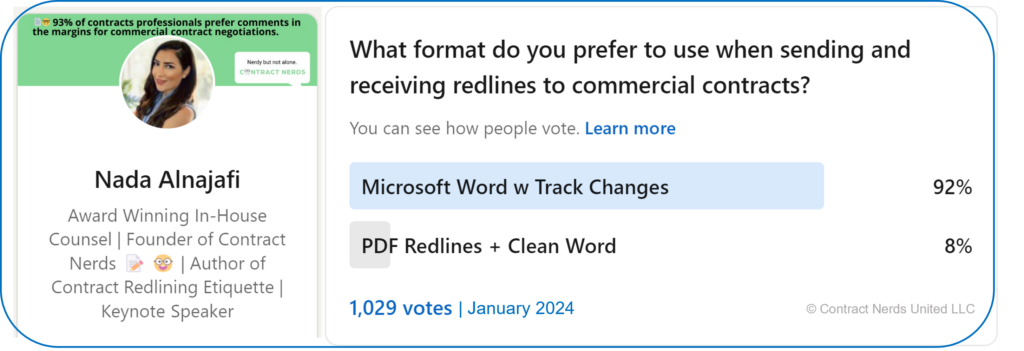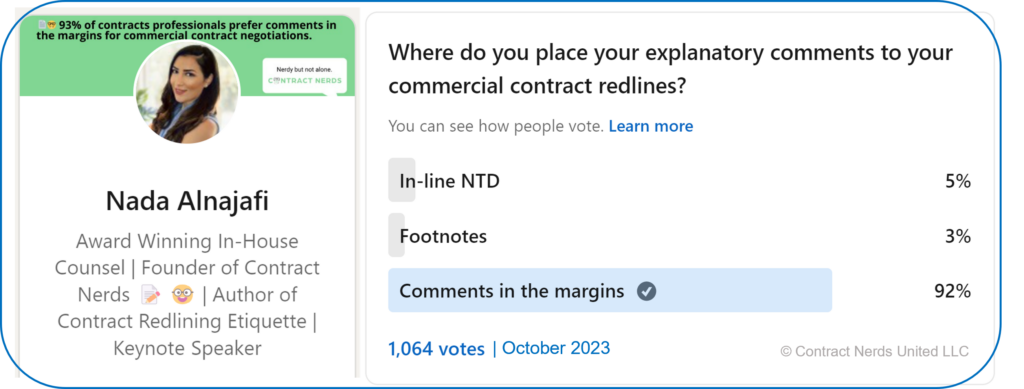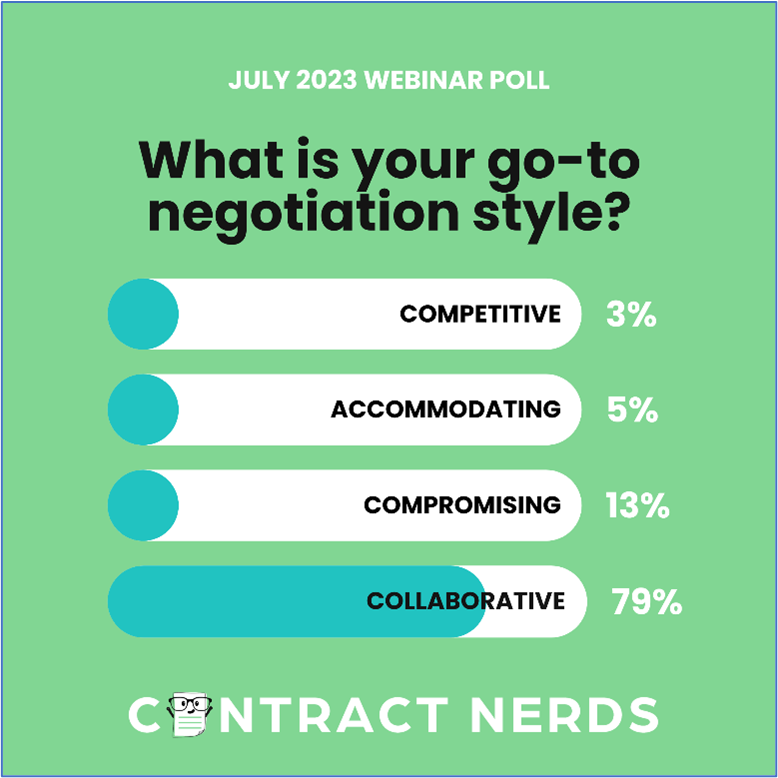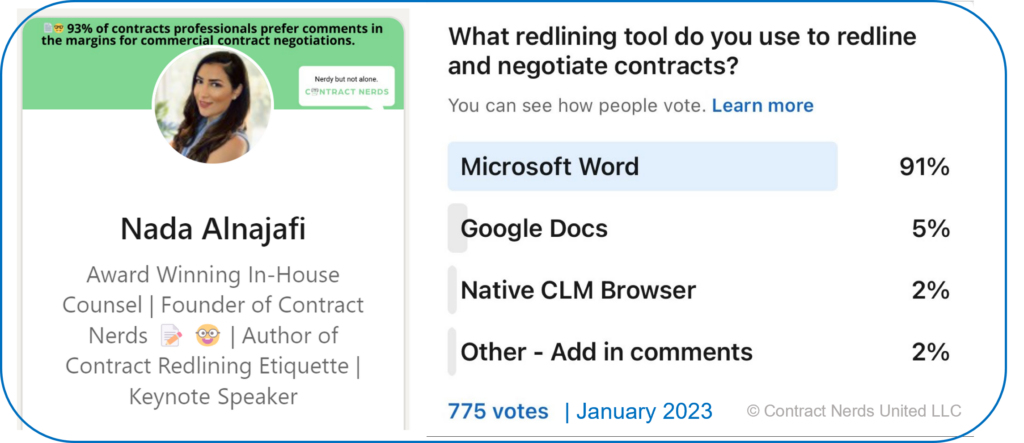KEY TAKEAWAYS:
- Input from the contracting industry shows that the redlining process is generally frustrating, inefficient, and slow.
- The principles of Contract Redlining Etiquette® are intended to promote transparency, efficiency, and collaboration in the contracting process.
- Recent data collected by Contract Nerds indicates clear and unequivocal standards that should be more widely adopted for smoother, more efficient contract negotiations.

“Contract redlines are more than just markups. They are a powerful negotiation tool.” This is the message that I have been resonating across my online platforms to improve the way contracts professionals redline and negotiate contracts.
Over the last three years, I have been collecting data through (both formally and informally) about contract redlining habits, frustrations, preferences, myths, and realities.
What I have learned, and what I’ll show you in this article, is that the data—what I call “Redlining Realities”–aligns with the teachings in Contract Redlining Etiquette® and my observations and experiences from having worked with contracts for over fifteen years.
The data shows polarizing stances on “controversial” issues. Revealing that the positions are not on the fence. They are loud and clear. Standard or not standard. Loved or hated. Indicating clear contract redlining best practices that should be more widely adopted for greater uniformity, satisfaction, and efficiency in the overall contracting process. Not just because I say it, but because the data says it too.
Redlining Reality #1– 79% of contracts professionals learn how to redline contracts while on the-job.

According to the above poll, 79% of contracts professionals learn how to redline contracts on-the-job. Not in law school, not in a formal training program, and not from a mentor or boss. Those who did are considered the lucky few.
And because most of us did not learn how to redline in a formal educational setting, we each redline in a slightly different way. This lack of uniformity within the redlining process creates many problems across the overall contracting lifecycle, including reduced negotiation leverage, longer closing cycles, and even loss of revenue for your organization.
And what we never realize is the emotional toll the redlining process can take on us. How many of us have felt frustrated, confused, or experienced a lack of confidence or broken trust? Imagine if we had a more organized and streamlined redlining process that was designed to help us reach our contracting goals and enjoy doing our job! That is exactly what my book, Contract Redlining Etiquette, and my related teachings, articles, presentations, webinars, and LinkedIn posts on this topic are meant to solve.
Redlining Reality #2– 92% of contracts professionals prefer to exchange commercial contract redlines via Microsoft Word Track Changes.

According to the above poll, 92% of contracts professionals prefer to exchange commercial contract redlines via Microsoft Word as opposed to PDF redlines. Seems pretty clear, right? But every time I present about contract redlining best practices, I am asked the question of Word vs. PDF. With at least one person expressing that they prefer PDF redlines over an editable format regardless of the best practices and justifications discussed in favor of sending editable markups.
For anyone who knows me, you’ll knows that I will always pick Microsoft Word Track Changes over PDF redlines. But we cannot create change without first understanding why things are the way they are. So I also like to explore this topic whenever I can, asking folks who prefer to use PDF redlines this one very simple question—Why?
Why some contracts professionals prefer to use PDF redlines
Here’s what I’ve heard, mainly from contracts professionals who currently or previously worked in big law, M&A, construction, or government contracts.
- “I don’t trust the other side.”
- “I like to be in full control and don’t want to take any risks.”
- “I don’t like the Track Changes features.”
- “I know it is not the most efficient method, but I’m used to it.”
- “My firm’s tool produces PDFs and is not compatible with Microsoft Word.”
Recommended approach for those who currently use PDF redlines
Most of the above reasonings can be solved through user training or redlining upskilling.
Here are a few of my recommendations for anyone who is still unconvinced by the data:
- Build trust – You can work on building trust with your counterparties through relationship-building and proactive communication. For example, when you send over the editable redlines, set out your expectations ahead of time.
- Master your redlining tools – Many of the complaints I hear are around frustrations with redlining tools, like Microsoft Word. (See the Redlining Reality #6 below.) When was the last time you took a course on how to redline contracts using Microsoft Word, or how to run document comparisons using a specific program? That’s a good place to start.
- Run your own redlines – You can also run your own redlines (run a document comparison each time the draft leaves your hands). This will address your fear that someone else is going to mess up your document or make hidden changes.
- Try something new – Change is inevitable but it doesn’t have to be big or sudden. It can be small and slow. My suggestion to anyone still using PDF redlines in the commercial contracting space is to try out some of these suggestions next time you have a low-stakes deal that you can experiment with. Worst-case scenario, you still hate it and go back to PDFs. Though I have a feeling you won’t.
Outside counsel with in-house clients should definitely be paying attention to this data point and delivering redlines in a format that their clients feel comfortable with.
Redlining Reality #3– 93% of contracts professionals prefer explanatory comments in the margins.

Comments are a critical redlining feature for contract negotiators because they help us explain the reasoning for our proposed changes, collaborate with internal parties, and ultimately drive the contract negotiation forward.
According to this poll, 93% of contracts professionals prefer explanatory comments in the margins for commercial contract negotiations. Not in-line NTDs or footnotes. When I was preparing to present a law firm training on contract redlining best practices to a group of big law M&A attorneys, I was a little nervous. Big law and M&A attorneys have different redlining protocols. Namely, they prefer to use PDF redlines. So I ran this poll to have a piece of hard data to take to the presentation with me. I was surprised but not surprised by the results.
While big law and M&A attorneys have long used footnotes and in-line NTDs for explanatory comments, the undeniable trend for commercial contracts is to leave comments in the margins. The reasoning is about much more than aesthetics. It has to do with visual design, efficient placement of important information, psychology, and ease of technical functionalities. I go into this in more depth during my training sessions but the takeaways are clear.
In-line NTD comments are the least effective and least efficient place to put explanatory comments. Use footnotes (for big law and M&A folks) or margins (for commercial contracts) instead. When your clients are in-house attorneys, it is best to put comments in the margins. Deliver work product to your clients in their preferred format for a smoother service experience.
Redlining Reality #4– 81% of contracts professionals will exchange two or more emails before scheduling a negotiation call.

During a recent Contract Nerds webinar, I ran several polls to gauge to the audience’s redlining and negotiation habits. According to this poll, a whopping 81% of contracts professionals will exchange two or more emails before scheduling a negotiation call. While 13% say they avoid calls as much as possible. This indicates that contracts professionals may not be taking advantage of an important negotiation tool sitting right under our noses—the phone.
Expert negotiators know that using a live method of communication (phone, video call) is magic. Getting on the phone helps to forge closer relationships with counterparties, obtain more datapoints that can be used by the negotiator (body language, eye contact, etc.), and ultimately close open items faster. Live negotiations place real-time pressure on the parties to make decisions.
But contracts professionals are so accustomed to working in email that we often forget about or avoid scheduling a call. In fact, using the phone is a great way to accelerate the negotiation forward. In my book, Contract Redlining Etiquette®, I recommend switching from email to a live negotiation call after one round. Of course, a shorter or simpler agreement (like an NDA) could be resolved on the phone without email. While a longer, more complex agreement (like a SaaS agreement) may need more than one email round.
Redlining Reality #5– 79% of contracts professionals see themselves as having a Collaborative negotiation style.

According to this poll, 79% of contracts professionals see themselves as having a collaborative negotiation style. And only 3% see themselves as having a competitive negotiation style. So many of us think we are being collaborative, but are we really? Do you redlines communicate collaboration as much as you think they do? Often times, your redlines are your counterparty’s first impression of you.
If you want to be a collaborative negotiator, then you should include clear, explanatory comments with your redlines. You should send redlines in an editable format rather than a locked PDF. You should proactively address your counterparty’s concerns and only propose reasonable changes to their template. The key for contracts professionals is to be sure that your negotiation strategy and your redlining strategy are aligned.
Expert negotiators will use different negotiation styles throughout their negotiations depending on which approach will achieve the best results. As they say, there’s a time and place for everything. It is a known fact that collaborative negotiation produces successful results just as much as a competitive style does. With the bonus of creating or saving the relationship in the process.
Redlining Reality #6– 91% of contracts professionals use Microsoft Word to redline contracts. But only 21% have received formal training.

According to a recent poll, 91% of contract negotiators (myself included) use Microsoft Word’s Track Changes features to redline contracts. But, according to another poll taken during one of my webinars, only 21% have ever received formal training on redlining in Word. This means that most of us are using a tool that most of us don’t know how to use.
It is important to master redlining tools so we can do our work as efficiently as possible without getting held back by user errors or unknowns. This means also staying up-to-date on new features and enhancements. Like how to hide formatting markups and how to change the author name.
Here are a few resources you can check to learn tips, tricks, and workarounds for redlining contracts using Microsoft Word.
- My Read Between the Redlines column on the Contract Nerds blog;
- My free eBook that you can download today; and
- My on-demand webinar with demos and real-life examples.
Redlining Reality #7– Contract redlining skills are important and needed.
As someone who lives and breathes redlines, I am (happily) blown away by the level of interest, passion, and curiosity this subject receives from new and experienced contracts professionals. This topic is not only important, it has been overlooked as a critical skill for far too long.
The data on this point reveals itself through: massive attendance rates at webinars on this topic, high engagement on LinkedIn posts on this topic, active discussions about this topic in webinar chats, and high read rates on articles on this topic.
All this to say that contract redlining is an important skill for contracts professionals. And there is a big need for better, practical education around this topic. I am passionate about helping create this change. And I choose to channel my energy into this field through my book Contract Redlining Etiquette, Contract Nerds, and LinkedIn. I also present at legal conferences, train legal departments and law firms, speak on panels webinars, present CLEs on this topic, and post tips regularly.
Please share this information with your team members, colleagues, and counterparties. I also invite you to follow me on LinkedIn to continue to master your contract redlining skills alongside me!
















